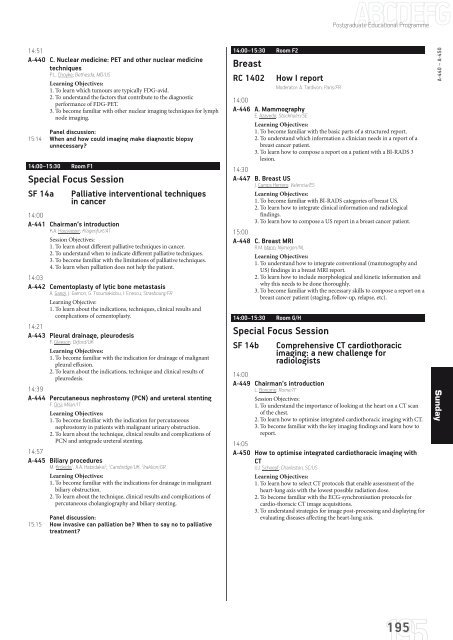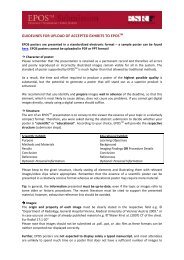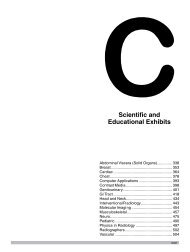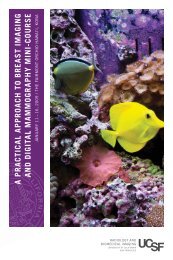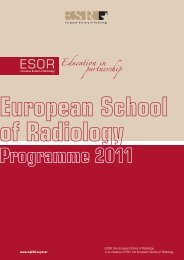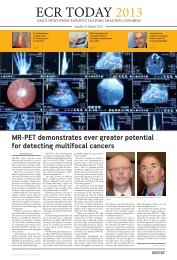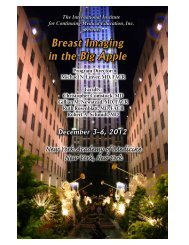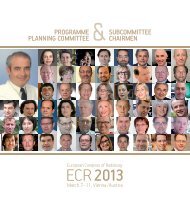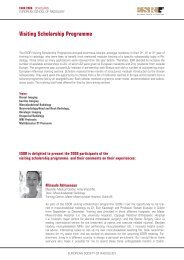ECR 2013 â Final Programme - myESR.org
ECR 2013 â Final Programme - myESR.org
ECR 2013 â Final Programme - myESR.org
- No tags were found...
Create successful ePaper yourself
Turn your PDF publications into a flip-book with our unique Google optimized e-Paper software.
Postgraduate Educational <strong>Programme</strong>14:51A-440 C. Nuclear medicine: PET and other nuclear medicinetechniquesP.L. Choyke; Bethesda, MD/USLearning Objectives:1. To learn which tumours are typically FDG-avid.2. To understand the factors that contribute to the diagnosticperformance of FDG-PET.3. To become familiar with other nuclear imaging techniques for lymphnode imaging.Panel discussion:15:14 When and how could imaging make diagnostic biopsyunnecessary?14:00–15:30 Room F1Special Focus SessionSF 14a Palliative interventional techniquesin cancer14:00A-441 Chairman‘s introductionK.A. Hausegger; Klagenfurt/ATSession Objectives:1. To learn about different palliative techniques in cancer.2. To understand when to indicate different palliative techniques.3. To become familiar with the limitations of palliative techniques.4. To learn when palliation does not help the patient.14:03A-442 Cementoplasty of lytic bone metastasisA. Gangi, J. Garnon, G. Tsoumakidou, I. Enescu; Strasbourg/FRLearning Objective:1. To learn about the indications, techniques, clinical results andcomplications of cementoplasty.14:21A-443 Pleural drainage, pleurodesisF. Gleeson; Oxford/UKLearning Objectives:1. To become familiar with the indication for drainage of malignantpleural effusion.2. To learn about the indications, technique and clinical results ofpleurodesis.14:39A-444 Percutaneous nephrostomy (PCN) and ureteral stentingF. Orsi; Milan/ITLearning Objectives:1. To become familiar with the indication for percutaneousnephrostomy in patients with malignant urinary obstruction.2. To learn about the technique, clinical results and complications ofPCN and antegrade ureteral stenting.14:57A-445 Biliary proceduresM. Krokidis 1 , A.A. Hatzidakis 2 ; 1 Cambridge/UK, 2 Iraklion/GRLearning Objectives:1. To become familiar with the indications for drainage in malignantbiliary obstruction.2. To learn about the technique, clinical results and complications ofpercutaneous cholangiography and biliary stenting.Panel discussion:15:15 How invasive can palliation be? When to say no to palliativetreatment?14:00–15:30 Room F2BreastRC 1402How I reportModerator: A. Tardivon; Paris/FR14:00A-446 A. MammographyE. Azavedo; Stockholm/SELearning Objectives:1. To become familiar with the basic parts of a structured report.2. To understand which information a clinician needs in a report of abreast cancer patient.3. To learn how to compose a report on a patient with a BI-RADS 3lesion.14:30A-447 B. Breast USJ. Camps Herrero; Valencia/ESLearning Objectives:1. To become familiar with BI-RADS categories of breast US.2. To learn how to integrate clinical information and radiologicalfindings.3. To learn how to compose a US report in a breast cancer patient.15:00A-448 C. Breast MRIR.M. Mann; Nijmegen/NLLearning Objectives:1. To understand how to integrate conventional (mammography andUS) findings in a breast MRI report.2. To learn how to include morphological and kinetic information andwhy this needs to be done thoroughly.3. To become familiar with the necessary skills to compose a report on abreast cancer patient (staging, follow-up, relapse, etc).14:00–15:30 Room G/HSpecial Focus SessionSF 14b Comprehensive CT cardiothoracicimaging: a new challenge forradiologists14:00A-449 Chairman‘s introductionL. Bonomo; Rome/ITSession Objectives:1. To understand the importance of looking at the heart on a CT scanof the chest.2. To learn how to optimise integrated cardiothoracic imaging with CT.3. To become familiar with the key imaging findings and learn how toreport.14:05A-450 How to optimise integrated cardiothoracic imaging withCTU.J. Schoepf; Charleston, SC/USLearning Objectives:1. To learn how to select CT protocols that enable assessment of theheart-lung axis with the lowest possible radiation dose.2. To become familiar with the ECG-synchronisation protocols forcardio-thoracic CT image acquisitions.3. To understand strategies for image post-processing and displaying forevaluating diseases affecting the heart-lung axis.A-440 – A-450Sunday195


